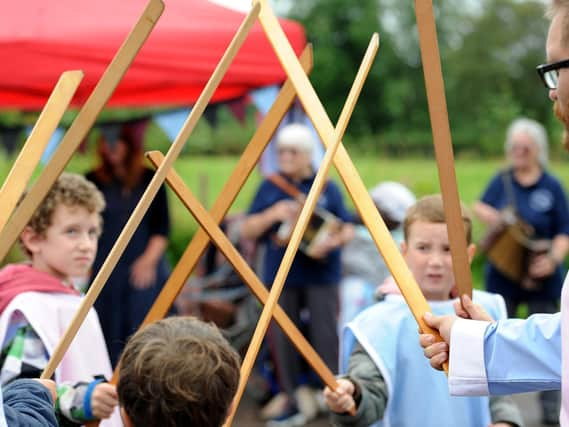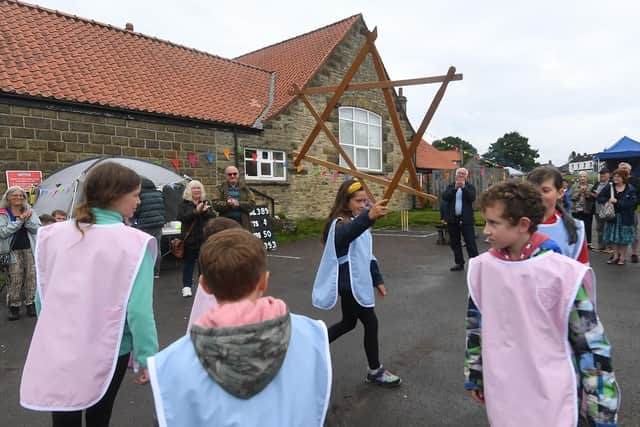The North York Moors village where generations come together to keep a pagan tradition alive


The Goathland Plough Stots are thought to be the oldest long sword dancing troupe still active and two weeks ago the children of the village school, who are learning the art, performed at Goathland Show.
Keith Thompson is the current president and has been involved since moving to the village in the 1980s. Keith said Goathland Plough Stots dancers were once wholly made up of farmers and their sons.
Advertisement
Hide AdAdvertisement
Hide Ad“In the days when I joined it was very much a village farmers’ team. Long sword dancing dates back centuries and the dances go as far back as pagan times when people danced around a sacred tree, stone or bush.


“Our long sword dances of Yorkshire are derived from Scandinavia. They were introduced into northern England and the Shetland Islands more than a thousand years ago. Shorter swords were used in Durham and Northumberland.
“Stot means bullock which were used as draught animals to plough before horses and then farm mechanisation changed farming. Having been a pagan ritual, sword dancing then became part of church life.
“Plough stot companies would drag a plough on their rounds of their villages on Plough Monday, as it became known, the Monday following January 6. It was on the Feast of Epiphany when men made their offerings of candles and gifts at the church alter for the Blessing of the Plough, the first Sunday after twelfth night.”
Advertisement
Hide AdAdvertisement
Hide AdKeith said what followed became something far more than just a dancing troupe on what was known as the Plough Tour.
“Villagers said their year never used to truly start until the Plough Stots had come a-calling. The Stots were made up of ‘plough jags’, men who dragged the plough around with them; plough boys, the younger lads who would go around rattling tins and collecting money; and dancers. The monies went towards buying seed for crops or community efforts such as doctor’s fees or places in a fever hospital for any villager in need.
“The Plough Tour took them as far as Pickering, Kirkbymoorside, Malton, Scarborough and Robin Hood’s Bay. They would stay out for a week to a fortnight performing at each town or village collecting money.”
Keith said his introduction to Goathland Plough Stots came about in a casual manner.
Advertisement
Hide AdAdvertisement
Hide Ad“Shortly after we moved here one of the local farmers asked me whether I was coming to dance practice. I had no idea what he was talking about. He explained it was sword dancing. I’ve always believed in being a part of the village you live in and immersing myself into it, so I went along.
“The Plough Stots were performing in Pickering and I was there on the basis of holding the banner, but the team was one short. I was given a long sword. I was told I had to dance and have never left.”
Preservation and the future of the Goathland Plough Stots has been close to Keith’s heart for many years.
“Our culture and heritage is very important to us and we are delighted that traditional country dancing of all kinds is back on the school curriculum. When it was dropped years ago it did untold damage to the encouragement of the next generations.
Advertisement
Hide AdAdvertisement
Hide Ad“Up until the pandemic came along we were teaching in five schools at Fylingdales, East Whitby, Goathland, Castleton and East Cleveland. A team of four of us, including two musicians would visit and we are looking forward to getting that back underway soon.”
Keith said that farmers and farming families continue to provide the backbone to the Goathland Plough Stots.
“Michael Atkinson of Goathland House Farm was president before me. Michael has sadly passed, but his son David and grandson Daniel are both still on the team; Keith Jackson of Brow House Farm and his sons Callum and Duncan dance too. John Atkinson and his brother Les who grew up at Thornhill Farm have been involved for many years.
“We have five teams and usually have around 30-35 dancers along with a lot more who occasionally join in. We don’t have Morris dancing around here. It has always been sword dancing and we have developed an exhibition dedicated to the Goathland Plough Stots in our community hub called The Hut.”
Advertisement
Hide AdAdvertisement
Hide AdGoathland Plough Stots have a famous member among their musicians, renowned folk musician and singer Eliza Carthy. Keith said she joins them when she can.
“Sword dancing teams always have fabulous fiddle and accordion players and we have some terrific musicians. Eliza is brilliant.”